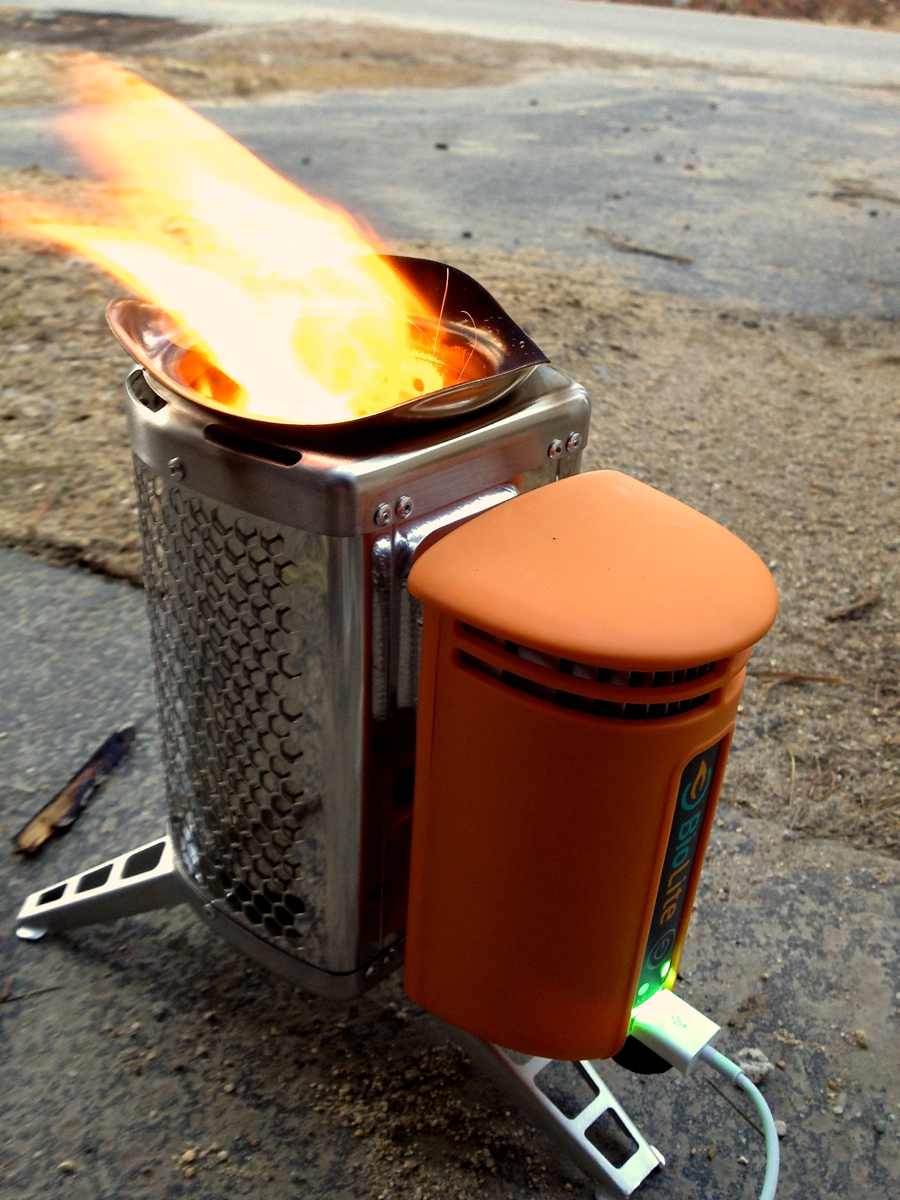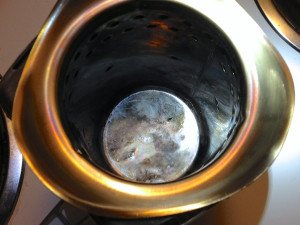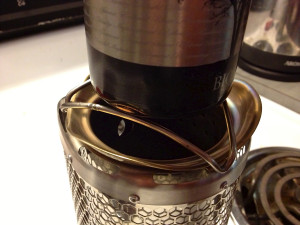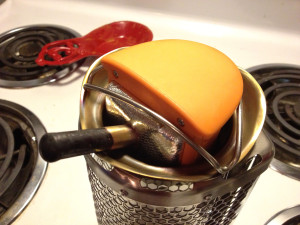We’ll start with the obvious. There are dozens of detailed video reviews already out there covering the BioLite Camp Stove. Some of them demonstrate ideal conditions. Some show you water boiling. Others show you windy conditions. The best of them, such as the one by MainePrepper, give you realistic materials, insights, and Bug Out Bag potential. If you’re here to learn about the TEG and the pros and cons over propane ‘pocket rockets’ you’ve come to the wrong place. This is a functional overview, and maybe just a bit… a bullshit meter for the YouTube reviews.
What is it?
The BioLite is a metal canister in which you burn wood. The top of the canister is set up to help you set a pot or metal cup on it for cooking or boiling liquids. It’s a wood-burning cook stove.
Why is it special, and what’s the orange thing?
The orange thing is an electronic attachment. It contains a Li-Ion battery, a fan, and whatever electronics are needed to turn the battery’s power into the right current for a USB port—which it has on the front of the unit. The unit also contains a Thermo-Electric Generator (TEG). This uses the probe on the unit to gather energy from the fire and turn it into electricity to charge the battery. The battery runs the fan at one of two speeds and powers the USB port. Why? Because iPhone…
That’s all I have to say about what it is. What I want to cover is how effective it is and what I believe its POU (Philosophy of Use) is. I also want to touch on some of the points that I was curious about before purchasing the BioLite, which I didn’t find answers for in the dozen-plus videos I watched. Excuse the photo quality in advance… I didn’t plan on doing a technical review so they were taken on the fly as I tested and cleaned the stove.
I found out about the BioLite about 6 weeks ago, through the Preparing for SHTF Facebook page (they post links to some pretty good outdoors products). I held off on purchasing between taxes and firearms costs, but then I got a 20% off coupon for REI, along with a reminder of my member dividend balance. I immediately bought the $130 BioLite on REI.com for $47 after my savings, with free shipping. The stove could suck and that would be good value.
P.O.U.
P.O.U. is an acronym coined by Nutnfancy, standing for Philosophy of Use. I think there are three solid uses for the BioLite: Car camping, emergency preparedness, and backpacking.
The use that will apply to the largest number of people is car camping, and here’s some bullshit metering for you… NO, it’s not just a gimmicky gadget for car campers. It’s certainly practical on top of its novelty. In video and text reviews I’ve seen vain, ass hat, blogger wannabes bashing the USB port’s practicality by saying “You could just charge your phone in the car.” Seriously? Can’t you find something useful to say? For starters, most cars won’t do that unless the key is turned to accessory, in which case your drawing battery power. More importantly, plenty of car campers—such as myself—are white-collar, salaried employees or execs. Why does that matter? Because they may actually need to keep a charged phone on them while on their leisurely vacation. Car camping is car camping. It’s not minimalist backpacking. I like the idea of limiting electronic use while camping, but even if my boss promised not to call, I might still want to look up the best hiking trail for tomorrow’s day-time outdoorsiness. Having tested the BioLite, there are numerous car camping situations that I can think of, in which I’d pick the BioLite over a Coleman propane stove. For heating/boiling fluids, as well as cooking anything in a pot, I’d use the BioLite and charge my phone up while I’m at it (that feature works as advertised, by the way).
Emergency preparedness? If I need to explain to you why this is useful for emergency preparedness, you’re not prepared. This would make sense for a Bug Out Bag which can double as a Bug In Bag. And don’t give me the, “But the cell network will be down, so you won’t need a cell phone” argument. First of all, most situations that would necessitate deploying an emergency kit don’t include the end of all infrastructure. Even if they did, there are rechargeable flashlights, hand-held radios, etc.. The bottom line is that it is as effective as it’s billed to be, so it makes sense for emergency use. When a snow storm or hurricane knocks out power in your region for a week but the cell network is still up, you’ll be grateful to be able to keep your phone charged.
Use of the BioLite for backpacking is going to be a more controversial issue. I won’t pretend to be an expert, since I’ve never been backpacking, however I’m smart enough to use my brain to filter the information I find online. I’m a gear snob, but I don’t feel a compulsion to bash good products to make myself feel better. I’m not going to try to sell the BioLite for backpacking. I’ve seen and heard arguments regarding weight and size, primarily. I call bullshit, myself. As I gather gear to try backpacking for the first time, the BioLite will be in my pack.
Does it really work or do I have to make it work?
I threw a third of a fire starter stick in the canister to get it started. It didn’t need more than that, and it would be easy enough to start it without one. I had no problem getting it running and it ran fine despite external winds gusting to 20mph. The power module comes with its internal batter partially charged. As you probably know if you’re researching the BioLite, BioLite recommends you condition the battery for 6 hours before use (charging through USB). My knowledge of batteries would indicate that this is a good idea, but I have a sneaking suspicion that the BioLite will turn out to be one of those products that just works, regardless of abuse. I didn’t condition the battery.
With a fire started, I kicked the fan on and it got up to a good burn quickly using crappy wood that felt dry, but had been in snow for the winter, so probably wasn’t. Turning the fan to high and adding a little more wood, the flames lick about 6 inches above the canister. I got the green light on the USB (indicating the power module was ready to charge something) at about 3 minutes after first starting the fire. Basically by the time the fire was cook-worthy, it was also charge-worthy. Functional by my thinking.
Once I had a serious coal base going (only about 4 minutes in), I stopped feeding it wood and let it run down. Realistically if you put the fan on low, and maintained more of a coal base than a licking fire, you could probably cook quickly on the BioLite without needing to feed it quite as much as you’ll see reported elsewhere. With the fan on high, it does eat wood with a fervor. Once the coals were dwindling, I dumped them out and let the stove sit to see when it would stop charging. It sort of didn’t. I let it sit for more than 5 minutes with the fan on low and no fire or coals in it. The green light stayed on and I turned the power module off after 5 minutes out of impatience to see how it cleans up.
Now I know I just gave you a data point that you’ve not seen in the other reviews, and you probably hate me for adding another ‘if’ to your research. I agree it was a bit odd, seeing as the reviews I’ve seen made it look like it was difficult to keep the USB at charging strength. It is what it is though, and don’t hate me too much because I’m about to share an element that very few, if any, of the other reviews cover. What happens to the stove after you use it?
It doesn’t clean up to its original sheen, but it cleans up alright. The rim, where you can sit a pot, and inner wall will be discolored afterward. It’s a fairly consistent, bronze coloration, but it will not clean up 100%. Mind you, this was covered in black carbon before cleaning, as would be any pot you put on the stove. This doesn’t bother me, but it seems to annoy some. Also the TEG probe will turn black and will stay black. Cleaning won’t get it shiny.
In the instruction manual, it says that the canister is dishwasher safe. FALSE. After my third time using the stove, I decided to machine wash the canister instead of the tedious scrubbing job I did the first two times. The inner wall and top rim of the canister developed a lot of surface rust. I think I can take care of this since I caught it early, but I strongly recommend against machine washing. Take the time to hand wash, and let the canister air dry completely before putting it away.
Another thing that I haven’t seen in any of the video reviews… I’ve noticed in two or three reviews that people will go to boil a cup of water and their small boiling cup is too small to sit up on the wavy rim. It instead sits in the dish of the pot holder and blocks the flame somewhat. I’m guessing BioLite realized this and added the accessory that came with my BioLite. They included a triangular metal piece that sits in the pot holder dish and allows you to use much narrower containers without blocking the flames. A nice touch.
One factor that I don’t think has been given enough credit is the head shield. The outer honeycomb is completely cool to the touch, even after 30 minutes of use. This is because the TEG pumps air at ambient temperature through the space between the inner chamber and the outer chamber wall. This keeps the outer chamber wall cool, and that’s an eighth inch away from the honeycomb heat shield. It’s very easy to pick up the stove to move it around during use, and the aluminum legs are on firm hinges so they won’t swing under the stove if you pick it up.
The BioLite is a compact, idiot proof stove, requiring no batteries, canned fuel, or serious maintenance. You can only screw this up if you machine wash it or can’t start a fire in the first place. Great product, even for retail price.





